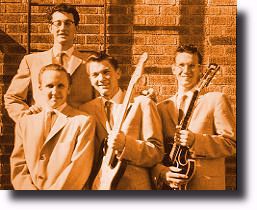Considered one of the founding fathers of rock 'n roll, Buddy Holly demonstrated his love for music early in life. As a child, Holly learned to play the violin and the piano. However, he soon discovered a preference for the guitar. Holly's parents, Laurence and Ella Holley, continuously supported the young artist in his musical ventures. By age 13, Holly and his friend Bob Montgomery were playing a kind of music they called "Western Bop," as well as mainstream country songs which they performed at local clubs.
Holly's first opportunity in the music industry came when a scout from Decca Records saw the duo opening a local rock show for Bill Haley and the Comets. Decca signed Holly, alone, to produce a few singles. Afterward, however, Decca decided Holly wasn't quite ready yet, and they advised him to return to Lubbock and keep working on his music. Holly followed the advice, and with the help of some friends formed his own band, "The Crickets." Holly was the group's guitarist and vocalist. Much of the band's music was produced by Norman Petty's studios in Clovis, New Mexico. Among the songs they recorded was a lively version of "That'll Be the Day," which caught Decca's attention once again. From that moment on, the group's songs were released on Decca's subsidiary, the Brunswick label.
The group's music talent, together with Holly's unique "excited" style of singing, quickly made them a success. Songs such as "Maybe Baby," "Oh Boy!" and Holly's solo hit "Peggy Sue" became extremely popular, especially among teenagers.
Holly and the Crickets also entered areas of music such as rhythm and blues, which until then had been exclusive to black artists. Once they were even mistaken for a black group and booked to perform at the Apollo Theater. Although at first the band was booed, by their third day of performing they had become a hit.
The Crickets were also extremely successful abroad. In March of 1958, they toured Great Britain, and eventually became more popular there than in the United States. Later that same year, Holly met Maria Elena Santiago, a receptionist for a New York City music publisher. Two weeks later, they were married. After a short honeymoon, the couple returned to Lubbock, Holly's home town. Feeling that the Crickets could produce their own music, Holly broke relations with Petty. However, the rest of the group didn't agree, and this caused Holly to leave the group. Soon afterwards, Holly and Maria Elena moved to New York where he performed with a new group of musicians.
|
 Buddy Holly and the Crickets
Buddy Holly and the Crickets
|
|
In 1959, as part of a rock show, Holly toured with Ritchie Valens and "The Big Bopper," J.P. Richardson. They began the tour riding from performance to performance in buses, which kept breaking down. One day, after a concert at the Surf Ballroom in Clear Lake, Iowa, Holly chartered a small plane to get the musicians to the next town. He had hoped to get them there with extra time to rest. On the morning of February 3rd, the plane carrying Holly, Valens and Richardson took off from Mason City, Iowa. Sadly, the plane crashed after traveling eight miles, and everyone on board was killed.
Maria Elena, pregnant at the time of Holly's tragic death, miscarried shortly after hearing the news. Years later, she remarried and raised three children. Maria Elena now lives in Texas and is a vibrant grandmother who tours the world promoting her first husband's legacy.
Despite a rather short career on the charts, Holly's innovative style, as well as his enthusiastic and energetic performances, made him one of the most popular singers in music history.
|
 A distorted photo of the plane crash which took the lives of Buddy Holly, The Big Bopper and Ritchie Valens
A distorted photo of the plane crash which took the lives of Buddy Holly, The Big Bopper and Ritchie Valens
|
|
|